You probably have questions about longboards. We all do. What are they? Why are they, two boards? How fast is it? What should I wear? Is it hard to ride? And the list goes on and on!
Trust me, you are not alone. I was once there, and so does countless people who want to jump into the world of boarding. I’m here to answer – and clear up – everything you’ve ever wanted to know but couldn’t ask – From finding out how exactly a longboard works to what you should wear, there’s something for everyone!
Without further adieu, let’s jump right in!

What is the difference between a Longboard and Shortboard Skateboard?
Shortboards and longboards have evolved to become very different from one another in theory, but the truth is that there isn’t really much of a difference anymore. The main factors are style preference and individual riding ability. On average, longboard decks are between 40″ and 46″ in length depending on their width, while shortboard decks tend to be between 28″ and 32″ in length.
How do I choose between a Longboard and a Shortboard?
All you have to do is take a look at your skateboarding style and individual riding ability. Do you like to ride slower, more technical boards or do you prefer the thrill of faster, more powerful turns?
Picking between a board that is too long for your style will result in frustration, so choose one that’s right for you! Most people who are just starting out seem to lean towards shorter belly boards because they can easily learn all the necessary techniques, but as they progress, each rider usually has their own preference for one type of board over another. Some people like longer decks (between 40″ – 46″), while others like shorter decks (28″ – 32″).
If it were me picking my first deck, I would go with something in the 40″ to 44″ range, but that’s just me. The boards are usually ridden with either a 151/4 or 163 wheelbase and trucks of some sort. The wheels you get really depend on how the board is to be used and also how aggressive it will be ridden. I would make sure to check out our Wheel Sizing Chart if you haven’t already done so, which should help you with your decision.
What kind of wheels do you recommend for somebody that does not like bumps in the road?
Actually, a larger wheel will be better in most cases to help absorb bumps and rough spots on the road. Even though some smaller wheels out there can handle cracks in the road, they are usually much harder than larger wheels and tend to break more quickly because of it. We recommend that your first set of wheels be at least a 70mm or 80mm wheel, with 90mm even better if you don’t want to worry about hitting any potholes.
Why does my Longboard stop suddenly when I hit a crack on the pavement?
The reason your board stops so suddenly is that you are most likely using cheap, soft wheels. If you had a larger wheel with more rigid urethane, it would have absorbed some of the cracks and bumps in the road instead of your board absorbing them and then transferring that force directly into your feet. With softer wheels, you feel every little bump or crack in the road, which can be very painful if your deck is not flexy enough to withstand it.
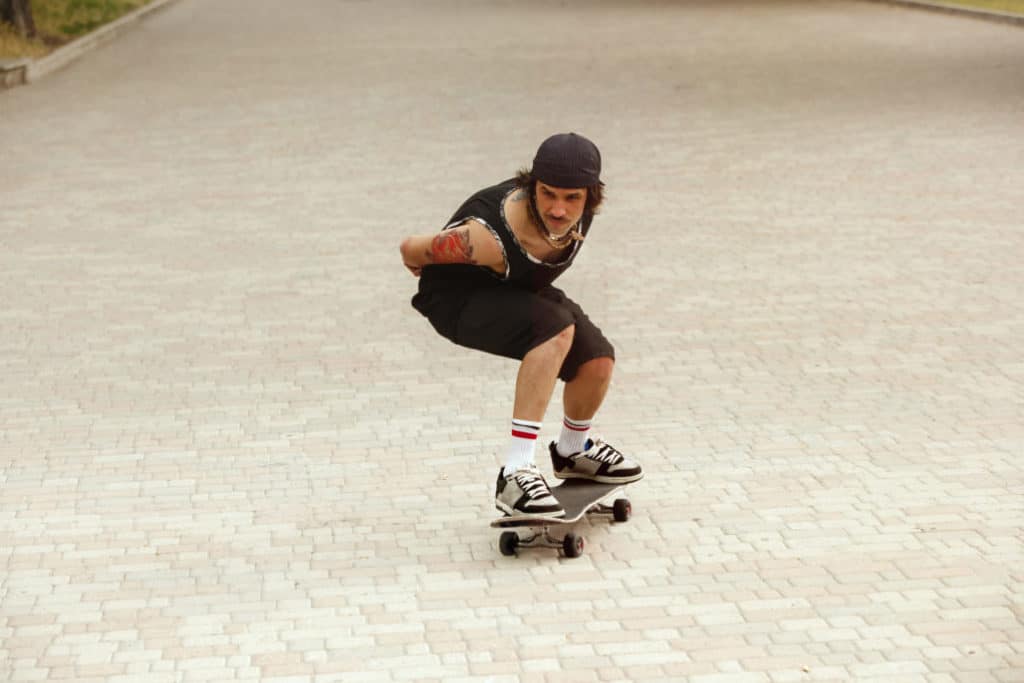
Why does my skateboard not go straight?
If you notice that your board does not go straight but veers right or left instead of in a perfectly straight line, most likely, it is not centred correctly on the trucks. When your wheels hit the pavement, they will begin to wobble and usually swing towards one side of the road.
Check your truck bolts for tightness at least once every two weeks, and make sure all four wheels are equally spaced from each other when riding. If they aren’t, you can end up with a slight bend in your deck, which can cause your Longboard to veer off course as well.
Will my Longboard work with FSKs or RKPs?
There are many different wheel setups out there like RKP (ReverseKing Pin) or FSKs (Flat Street Kingpin), and not every setup will work with your Longboard. The general rule is that you can’t use any sort of truck with a hanger width wider than 180mm, and you should never use trucks under 175mm wide, even if it is just one truck. This means that you can only use RKP in the front of your deck and have to stick with standard kingpins (180mm – 184mm) in the back for your longboard wheels.
What size are my skateboard bearings? 8mm or 10mm?
Most new decks come with 8-ball bearings, but many riders prefer the feel of ball bearings, so we carry both sizes! Either way, the size of your bearings doesn’t matter, and you can have the same quality in either. Make sure to check out our Bearing Guide if you still aren’t quite sure what all this means!
Do I need grip tape on my Longboard?
When it comes to learning to slide, the grip tape is pretty much a necessity if you won’t know how to get into slides easy and fast. Without grip tape, your board will just spin or slip out, which is not ideal for beginners trying to learn the basics. Also, if your ride has rails that are well done with lots of fine detail (like pool coping), then some light sandpaper wrapped around those spots can make it even better for sliding. However, this helps more advanced riders who already know the basics of sliding.

How do I maintain my skateboard?
-Make sure to wash your skateboard at least once a week to keep the dust and dirt from piling up.
-Lubricate all parts of your skateboard every 2 weeks with a damp cloth, especially if you ride daily. If your board is extremely dusty, use a toothbrush or nylon brush to clean out any grime hiding between the cracks.
-Keep up with tightening your bolts on your trucks at least every two weeks! For some reason, this seems to be an ignored part of longboarding, but it is probably one of the most important steps you can take in maintaining your board. Most longboards come with an Allen wrench for tightening their truck bolts (if yours doesn’t have one, check underneath the grip tape!). You should only need to do this when your wheels are re-trued or after you have washed your board.
Can I use WD40 on my bearings?
WD40 is a degreaser, and it will take the oil out of your bearings. Re-greasing them after using WD40 will also take longer because you must wash off the WD40 first; otherwise, they won’t re-lube properly unless you use alcohol to get rid of the grease. We recommend using a water-based bearing oil instead (like Bones Speed Cream), or just wipe down your bearings with rubbing alcohol if you are really in a bind.
Do these wheels come with cores?
Wheels without cores are considered ‘semi-cored’, and although there has been some debate on whether this actually makes any difference at all, we have found that semi-cored wheels do not slide as well as cored wheels. If you are looking for a slide wheel, we recommend getting a set with a core.
Do wheels come with bearings?
If it doesn’t say “Set of 8” in the title or description, then it does not include bearings! The size of the bearings is given in mm’s, and most boards come with eight of those bearings (8x8mm) unless otherwise noted in the product listing on Amazon.
Note: Most longboard trucks can accommodate two different sized wheels, so make sure to measure your truck first before you buy new wheels if these aren’t quite right for you as they may be slightly too small or big according to your board’s stock parts.

When do I know I need new bearings?
You might not need to replace your bearings soon after you feel wheels being a bit creaky, but if you feel like your wheels aren’t as smooth as they used to be when turning (especially when rolling downhill) or just want to replace them for the sake of maintenance and freshness, then we suggest replacing your bearings about every two months depending on how much you ride.
Some boards come with very tight trucks, so after tightening up your truck screws, sometimes you may find that skateboard’s wheels don’t spin straight unless there is a little play in the bearings. If you start getting uneven sliding at the beginning of a turn, usually, it means that the bearing is loose.
Typically tightening up each wheel will fix this issue and stop your Longboard from wobbling around while riding. On the other hand, if you go to loosen the screws and your wheels have no play at all (the wheel doesn’t spin freely), then you might need some looser trucks. If this is the case, then tightening them up will probably make the wheel not spin freely or not at all. Wheels that are very tight are usually only a problem on stock parts found on cheap longboards.

What do I do when my board gets wet?
If your board gets wet, just let it air dry completely. Once there is no longer any moisture in the wood or wheels, then you can use a blowdryer on low heat to speed up the drying process. If you jump right on your board after you get out of the pool or ocean, then it will be fine – but if you are riding in rainy conditions for extended amounts of time, we suggest getting a rain-repellant spray that specifically says it will work on longboards.
Don’t store your board wet unless it’s drying!
Do I need to wax my deck?
Some longboard decks come with a sanded grip surface (where the top layer of wood is removed so that your feet will stick to it while riding). You don’t need to wax these boards at all, but if you prefer the texture of non-sanded wood, not using any skateboard wax will cause dirt and gunk to build upon your deck. So we recommend getting a little cheap block of skateboard wax, rubbing it into the raw wood where your feet touch, and then wiping down any excess with a dry rag or paper towel – this process should take about two minutes per board side.
If you have grip tape on top of the bare wood, then go ahead and use a sheet of 400 grit sandpaper (or something similar) and take off all the texture from the grip tape. This will give you a smooth surface to wax, and if you plan on using this board for sliding, then you might also want to make sure that it is nice and dry before applying any skateboard wax, or else it won’t stick as easily.
If your longboard deck has clear grip tape (like most Omen boards) and you would rather not sand away all of the tiny bumps in the top layer of wood, then don’t use any skateboard wax at all – this will keep dirt/gunk from building up on top of your grip tape!
What kinds of things can I repaint my board with?
You can use almost any water-based spray paint to repaint your Longboard, and we suggest going with whatever colour you want. Keep in mind that white, silver, grey, black, and blue look the cleanest/sharpest – but you can go ahead and experiment with other colours. Make sure you don’t spray paint the wheels!
We do not recommend painting ANYTHING on top of clear grip tape. The acrylic layer is probably what’s keeping it from getting all messed up in between your feet so if you paint over it, then be prepared to either scrape off a whole sheet of grip tape or sand down the top of the deck pretty aggressively before applying new grip tape. If you are looking for an alternative option, then check
Usually, we recommend avoiding paint unless you absolutely need something waterproof – like if your board is beaten up and you just want to cover over the scratches without putting on a new layer of grip tape.
How do you Speed up wheel breaking in process?
Most longboard wheels take about two weeks to fully break in, but here are some tips that will shorten this time: 1.) Don’t lock your trucks! Leave them turning slightly so that they continue to get broken in as you ride, 2.) Put a little baby powder or cornstarch (talc) between both sides of each bushing and the hanger of your trucks
This will help prevent unnecessary abrasion between the truck parts, which would otherwise prematurely wear out the bushings and make your trucks feel stiffer than necessary.
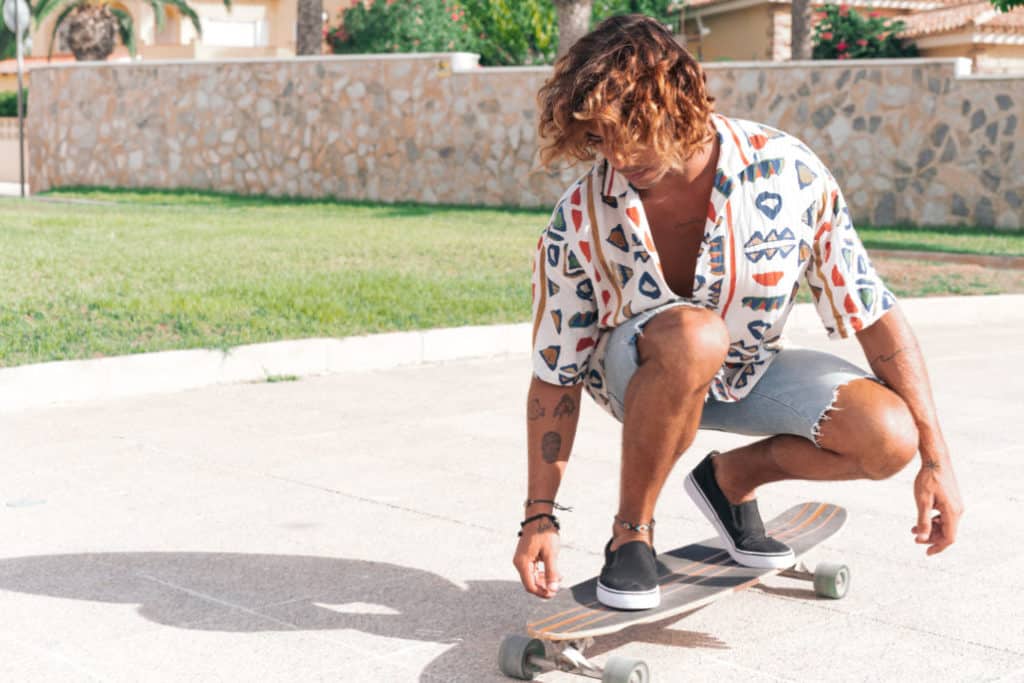
How can I prevent popping hovers/wheel bite?
Wheel bite occurs when your wheels come in contact with an object that is below its level, and this causes the wheel to stop abruptly. To solve this problem, you need to raise your deck above the obstacles that are causing the wheel bite.
What Causes wheel bite?
Deck angle: If you have a sharp kingpin angle (50+) on your trucks, then you might experience wheelbite while trying to manoeuvre, especially around corners at higher speeds. You can fix this simply by lowering your hangers, so they are closer and parallel with the road or buy new risers for more height adjustment options.
Soft bushings: Soft bushing allow for greater movement of your trucks, which will cause them to fall into objects that are lower than they should be
Why do I lose control when I go downhills?
There are two most common reasons why: 1.) You don’t have good turning trucks 2.) Your wheels aren’t soft enough
To fix the first issue, you can get some cheaper turning trucks like TKP’s or Randal trucks. Another thing you could try is loosening your kingpin (the bolt on top of the truck) such that a turn can be achieved with less effort.
The second problem happens when you use hard wheels, which you should always avoid because they will start to wear out faster and make more noise as well as slow down overall. The best scenario would be to buy soft bushings AND softer wheels for an even better ride.
Someone told me to flip my hanger; what does that mean?
When you turn your truck upside down, it lowers the angle of the hanger and makes a more stable ride (less wheelbite). Flipping the hangers is just that, unscrewing them and swapping sides!

My board is too stiff/won’t turn easily; what can I do?
You’re going to have to loosen up your trucks by adjusting the hanger bolts. Tighten them all the way until they don’t go any further, then back one or two off about 1/8th of a full rotation so that there is room for some movement. You will want to play around with this quite a bit because tightening these things too much will make your wheels lock when turning, which is no good! The goal is to make your trucks just flexible enough so that they turn when you want them to without popping.
What does ‘stance’ mean in relation to longboarding?
Stance refers to the distance between axles of a longboard truck. It also affects how quickly a skateboard turns, as well as its overall manoeuvrability. Shortening one’s stance is an action that is common to bulldog/dervish longboarders and is a great way of improving performance.
How can I make my board turn better?
If you simply want to de-stress your ride, then buy softer wheels and make sure your bushings are very soft (preferably just oil) and remove all unnecessary risers from the setup. If you want to go extra soft like the technical skaters do, check out these tips: -Shorten your truck’s hangers for a tighter turning radius -Buy bigger trucks with larger axles for more leverage over the wheels -Loosening or removing kingpin bolts will also help with tight turns What else could I modify on my board in order to make it turn better? Thick, hard wheels are notorious for bogging down and not letting you change direction quickly. Experiment with soft wheels until you find your optimal setup!
Will getting better bearings make me go faster?
Yes, it depends! Speed Bearings are best for downhill racing because they can handle very high speeds with ease! They’re also quite inexpensive compared to ABEC-9 or Ceramic Bearings. On the other hand, you don’t need that much speed when going downhills, so it’s better to just get some cheap Abec-3 or Abec-5, which will last for weeks if not months on your board at the cost of less performance in comparison.

What are bushing seats?
Bushing seats are the containers in which bushings sit in. They come in many different shapes and sizes, but for downhill, they need to be hard so that they don’t flex when you’re going over things on your board. Certain types of bushings can be used without a bushing seat if you’re tight on space; however, it’s better to just buy one especially considering how cheap they are!
Top mount vs drop through: what’s the difference?
When talking about skateboard trucks, top mount refers to the axles being mounted above the deck, whereas drop-throughs have their axles mounted below it. Some people may say that top mounts result in quicker turning because of their lower centre of gravity, but this is not true. The lower centre of gravity does allow for a more stable ride, but it also makes the decks less comfortable in the feet as well as heavier because of the additional material above them.
I’m interested in sliding: how can I make my board slide better?
Some people say that cutting your wheels shorter will give you traction even at low angles. This is not true! If you’re still struggling with slides, then increasing your wheel hardness and buying smaller bearings will help immensely. Make sure to buy Longboard specific wheels if you are serious about doing slides on this setup, though!
Are there any other things I can do to improve my setup turning capabilities?
Yes! Tightening your kingpin bolts to the maximum will make it so that the wheels and trucks move as one. This way, you can turn on a dime with very little effort, which is extremely useful for technical riding!

What’s TKP! And what does it mean?
TKP simply means Top Mounted Precision (Polar) Trucks. When people say this, they’re referring specifically to longboard truck setups constructed by Polar Skate Co because of their superior hanger design and bushings. What makes these trucks so great, you ask? -Because the kingpins are mounted on top of the board, they have greater leverage over the wheels, which results in much tighter turning radii than any other truck setup, especially when combined with short hangers. -Because they use a disc-shaped washer system to lock the bushings in place, it is harder for them to come off or even deform when under load (they can actually snap if abused enough). TKP trucks are not only great performers but also of exemplary quality, so if you’re looking for something that’s gonna last longer, then these are the ones!
I want Longboard specific wheels; where should I look?
If you want wheels specifically designed for downhill, then check out Orangatang because they have developed the world’s best wheel ever, the Stimulus! It has a special urethane formula that gives it high levels of grip without sacrificing speed, and it’s so large that it even comes in 80 and 83mm! I highly recommend getting the 80mm for downhill because they slide a lot better due to their short contact patch, but if you want something faster, then 83’s are the way to go. How do I clean my bearings?
For cleaning bearing, simply put them into rubbing alcohol or acetone and shake them around. You will hear small debris rattling around inside of them, which shouldn’t be there if you lubricate your bearings correctly. If this happens often, then take some time to write down what you normally do wrong so that you can apply proper maintenance practices from now on!
What’s this Abec rating thing?
Should I get really high rated ones? I’ll try to explain it as simply as possible. ABEC is a rating system used for ball bearings that has nothing to do with skateboarding. Although you can use higher rated bearings, their quality may vary, and they are more expensive, so I don’t find them to be worth buying unless you’re purely looking for speed!
How should I lubricate my bearings?
You should lubricate your bearings every time you ride them. A good way to do this is by using a q-tip or something similar that can reach the very centre of the bearings and apply a bit of non-waterproof bearing grease. It’s also really important to clean your bearings before any session because if dirt gets in there, then it will destroy them!

How can I protect my board?
They make these covers called ‘dustbags’ which are just small bags with dust/pollen filters inside so that you don’t damage your graphics when storing your Longboard away. You can get them pretty cheap from any online retailer, so they’re definitely worth buying! If you’re unlucky enough that you need a better solution, then consider buying a full board bag or even a small pad for your precious deck!
Do I really need to wax my board? What do you recommend?
Waxing a longboard is necessary because the un-waxed surface will get scratched and then damaged. So… yeah, definitely purchase some good skate wax and apply it in a circular motion with an old t-shirt or something similar. After you’ve done that, you can start skating again but make sure that your board remains under control at all times so that it doesn’t hit anything!
How much should I lean when turning?
Putting more weight into your trucks will turn them faster; leaning back, on the other hand, slows down your setup. Experiment with this by pushing yourself around using only your body and push yourself in a certain direction to get an understanding of how it works!
I should invest in some regular skate bearings instead of Longboard specific ones, right?
It really comes down to your personal preference, but I would recommend getting longboard specific equipment as they are designed specifically for downhill. Tightening ABEC-7 or Abec 9 bearings may also crack them, so use common sense too when tightening them up!

What do you mean by “wheel hardness”?
A skateboard wheel is made out of polyurethane which is a soft material by default. To make them more durable, their manufacturers add plasticizers to the mix, which results in a harder, more durable wheel that’s also heavier and slower than regular wheels because of its density.
Why should I choose lower hardness wheels for downhill?
Similar to bearings, this will keep your board moving faster rather than slowing it down due to easier sliding! Obviously, though, I don’t recommend you going as hard as me; if you can handle high speeds, then go for it if you want! Otherwise, just remember that lower numbers are harder while higher numbers are softer. The Orangatang Stimulus wheels mentioned above have an 85a rating, and they’re amazing for those looking for a good all-rounder.
I’ve used the same bearings and wheels for an entire summer; what should I do?
It’s been a while since you’ve cleaned your equipment, huh? As I mentioned before, clean both sides of your bearings after every session because if dirt gets inside them, it will harm their rotational speed and also damage them if ignored! If you’re really too lazy to clean your bearings, then at least throw something on them to shield some of the dirt that’s coming in from below, like wax or something similar. What about my wheels? Keep in mind that they are more durable but less centralized, so rotating one wheel with a different bearing can ruin its life cycle rather quickly; I don’t know how long that will take, but I’ve had a set of wheels wear out after an entire summer because they were forced to rotate with one broken bearing!
How do you (mark?) grind rails?
Yeah, this is really simple and requires no experience at all. For those who have only ever stuck to sliding along the top of a rail, you’re going to be surprised by how easy it is to actually ride them now, but what’s more, grinding isn’t as hard as you think, even if you’re not experienced! Warm-up on a ledge or something similar before jumping onto the rail itself; just make sure that your setup is under control! Remember not to lean back and keep speed in mind when entering a new obstacle for the first time so that you don’t accidentally hit it!

How do you perform a tailgrab (ollie) on a rail?
Again, this is really simple and requires no experience at all. Grab your board with one hand as you approach the rail and bend your knees to absorb some of the impacts; land on the rail with both wheels first by using your other foot as an anchor point similar to how you would if grinding but without dropping in. Once you’ve done that, get control over your setup again so that it’s not moving around too much. If you miss the landing, there are three things that can happen: Your setup will flip from underneath you, which means that you’ll fall right off; You’ll grab onto something like a ledge or curb while falling, which means that you’ll go down with your board or You’ll land on your wheels and use them to break the fall.
Usually, I prefer grinding for a couple of feet instead of trying to ollie onto something because it’s easier and safer if you don’t succeed but in case you haven’t tried either one before, then definitely give this one a try! If you’re struggling to land on the rail itself, then just practice grabbing higher up; obviously, lower rails are better than higher ones at first, so keep that in mind as well. You can also learn tricks like popping ollies from grinds, but I recommend doing these after practising all other aspects of longboarding since they require some serious balancing skills!
How do you perform body wheelies?
Body wheelies are an essential part of ollieing, especially for cornering ramps and doing various other tricks, so it’s important that you learn them very quickly! The setup required is simple enough; just warm up on a couple of straight slopes before jumping onto something in the shape of a ramp or circle. I recommend using a low setting at first since this will decrease your chances of getting hurt as well as increase your chances of success; if you can accomplish it, then do another try on a higher setting and so on until you’ve worked out how high of an angle you can perform these body wheelies from which will definitely come in handy later! What about grinding? Just like with sliding, body wheelies require speed and balance, so the main thing here is to make sure that your setup is under control and not moving around too much; try to land on your wheels as soon as possible because you’ll be able to stop more quickly if you do.
How do I grind a curb?
Grinding curbs can be pretty difficult at first, but they’re definitely worth it once you’ve learned them since they’ll slow you down in order to corner properly, which, in turn, will reduce the amount of speed that you have then will allow for easier balance when ollieing or using other tricks! Just like with slides, remember not to lean back; keep speed in mind when entering a new obstacle for the first time so that you don’t accidentally hit it with a high impact and make sure that your setup is under control before you actually grind it.
The main difference between grinding a rail and grinding a curb, though, is that your foot placement should be different. For rails, you’ll want to place one foot on the ground while using the other as an anchor point; for curbs, placing both feet right next to each other is essential since this will allow you to use all of your weight in order to break your fall if you miss! This also means that you shouldn’t drop in when doing this, or else it may end up being a pretty painful experience!
I’ve heard about sliding 180’s – what are they?
Sliding 180’s are probably easier than ollieing, so I would recommend trying them out before anything else! Basically, you start with a slide, and after it’s already in progress, you slightly turn your body towards the direction that you’re sliding in order to get back on your feet which is where most people have problems at first. This will require a tail tap, but all it amounts to is just tapping the side of your board at an angle so that it creates friction with the ground; just practice by doing this before hitting something higher off of a curb then going around 180 degrees on such surfaces.
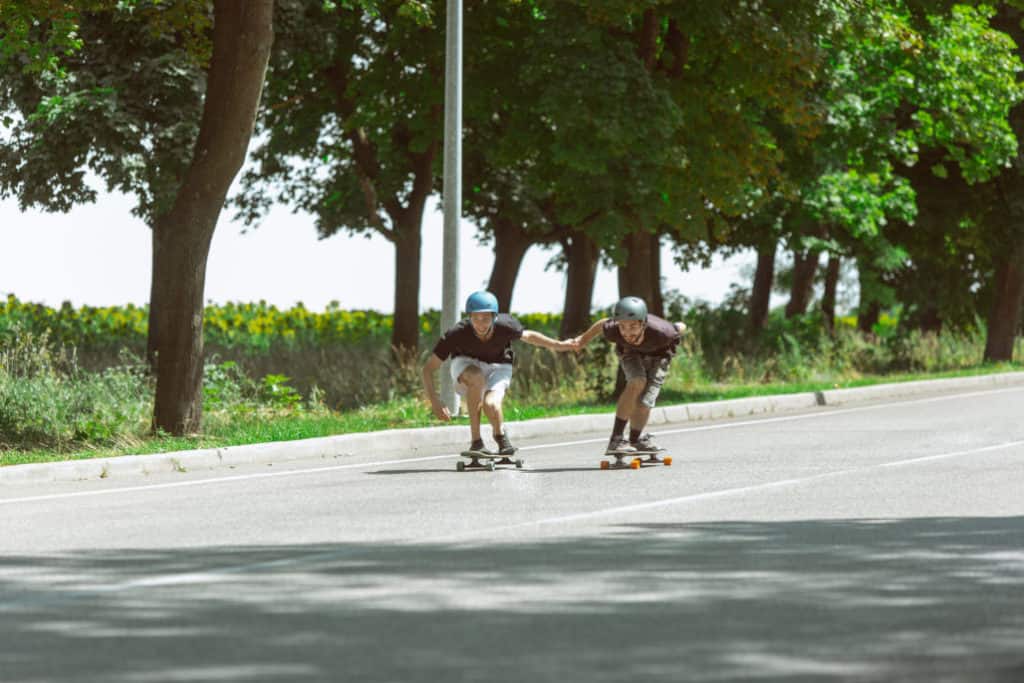
What effect does the durometer have on my ride?
This is an important question to ask when looking for new wheels! Durometer refers to the hardness level of your wheels, and for slideable wheels, it’s usually something around 78a – 82a. This basically means that:
The higher the number, the stiffer it will be; The lower the number, the softer it will be.
What this means for you is that generally speaking, soft wheels are more useful for sliding, while stiffer ones are better if you’re interested in grinds and other tricks since they’ll allow you to keep your board under control even at faster speeds! Just remember, though, that these numbers don’t mean anything in particular, so a wheel advertised as being 98a doesn’t necessarily have double as much rebound as one that is 88a!
Why should I use a specific wheelbase?
This is probably the question that gets asked most often, and while it’s not really possible to give you a single answer here, one thing that can be said for certain is that it depends on your style of riding; for example, if you’re into sliding then longboards are good since they will make grinds slightly easier, but if you’re more interested in tricks then shortboards might fit better with your style of skating.
The main reason why this comes up so frequently, though, is usually because there isn’t any set rule as to which length is better; different people have different styles of riding, and what works best for me personally may not work well for someone else.
What kind of wheel should I buy?
Probably the only way to answer this question is by giving you some pros and cons, but that being said, there are a few wheels that I’d recommend for everyone.
If you’re just starting out with sliding, then Cruiser Skateboard Wheels will probably be the best choice since they provide a pretty fair mix of slideability, speed and grip! These are also quite affordable, so if you end up falling in love with skating after using one of these, then it would make sense to just get more of them! If your budget is a bit larger, though, High Rebound Low Profile Slideable Stiff Trucks seem to be incredibly popular since they come stock on many brands of decks and skateboards sold today; this means that you’ll have no trouble finding replacement parts for these and if you’re looking to upgrade your ride, then they’re also fairly cheap!
If you already have a board but are interested in buying new wheels, then Inline Skate Wheels might be the best choice since they use bigger cores than most Slideable Wheels, which means that it will be easier for you to slide them; there isn’t really any other advantage to using these, but I’d recommend this if sliding is your main goal!
What kind of truck should I buy?
I’d recommend using street trucks if you’re looking to use your board for cruising or long-distance skating since they are quite versatile and can handle most conditions you’ll encounter out on the streets; they also have a pretty large turning radius which is something that will be needed especially when it comes to grinding.
If you want more control over your ride, though, then high performance trucks like radial and standard should be good since they usually ship with wheels that allow you to really accelerate your rides. These are both very stiff, though, so if this is what you’re interested in, then replace them with slideable wheels!

What kind of deck should I get?
This is something that will be determined by your needs and riding style.
If you’re a beginner, then classic longboards might be the best choice since they are usually the most affordable; if you already have some experience, though, then you can go with a shorter board since this will make grinding easier as well as give you more control over your rides! Because of this, I recommend using short decks for tricks because these are much harder to learn on longboards since even the slightest mistake could send you flying off your deck!
What should I look out for when buying my first board?
The main thing that all beginners should look out for is core quality, and while it’s true that just about every board nowadays has cores made from high rebound urethane, the quality has a huge effect on how long your wheel will last; in general, if you’d like to keep using one board for multiple years then make sure that it comes with high rebound urethane that is not overly brittle.
What kind of deck should I buy?
I’d recommend using a cruiser deck if your main goal is to cruise around the city or just enjoy a long-distance skate. This has larger wheels so that you can go faster, and since you’re not really concerned about tricks, this shouldn’t serve as much of a problem!
If you’re looking to do some tricks, though, then I’d definitely recommend using an old school board instead because these have smaller wheels and will be easier to balance out on when doing manuals for example; these boards are also made from wood which means that they will break easily if dropped!
What kind of trucks should I buy?
I’d definitely recommend using street trucks if your main goal is to go fast. These are made from aluminium, so they are a lot lighter than high performance trucks, and since you want to be able to accelerate as fast as possible, this will do the trick since it means that you’ll be able to build up speed; much quicker!
If your main goal is doing tricks, though, then I’d recommend using longboard trucks instead because these usually come with large bushings, which help make riding easier; however, keep in mind that these bushings won’t last quite as long when compared with street truck bushings.
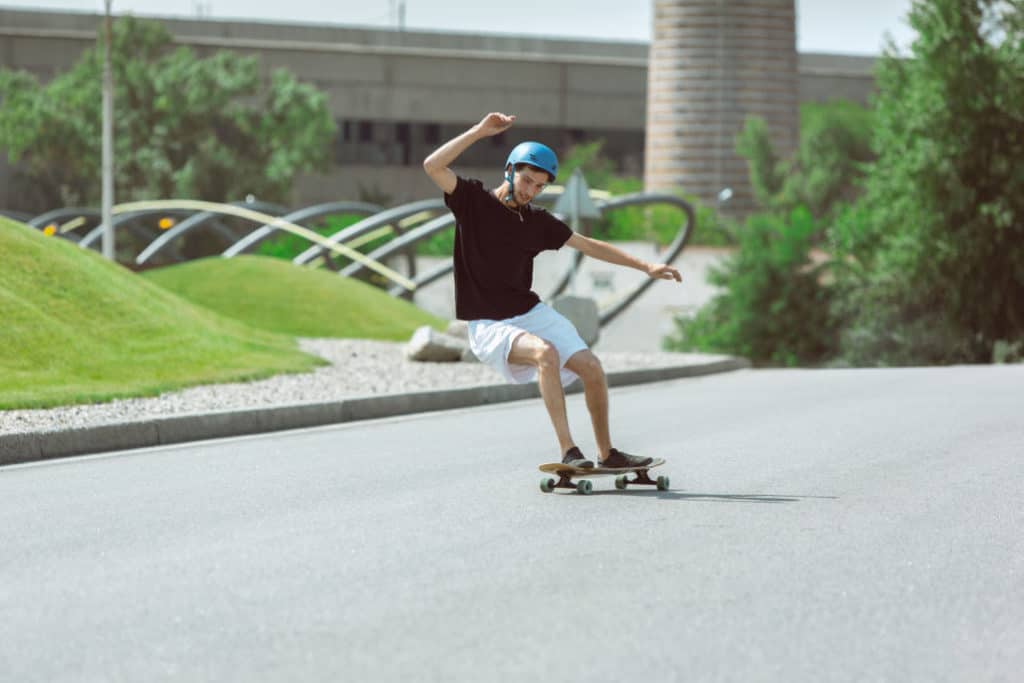
What kind of bearings should I buy?
The first thing that you should look out for is ball bearings since not all of them are created equal; even though there are plenty of good brands out there, WEARSKATE has top quality products, but if you’re looking to save some money, then I’d recommend HYBRID BRONZE since these have a delicate design which means that the contact surfaces will be polished after being cast so they’ll last longer than most other sets!
If you’re really into grinding and cruising, though, keep in mind that ceramic bearings can handle speed incredibly well, but at the same time, they aren’t the best when it comes to grinds since ceramic balls get worn; down easily! This might work better for those who plan on using their board strictly as a cruiser, though!
What kind of grip tape should I buy?
The main thing that you should look out for is grit since the more abrasive it is, the stronger your deck will be when doing slides. However, bear in mind that this can be a double-edged sword because if you’re a beginner, then having an abrasive grip tape on your board might make learning new tricks difficult, so if this is your case, then I recommend using a softer one instead!
How can I stop my Longboard from wobbling when I go faster?
If your board is wobbling as you go faster, then the first thing that you should look out for is your wheel alignment because if this is off, it can lead to irregular load transfer and make riding difficult; the best practice would be to use a longboard set up a tool such as Rockett’s Longboard Hardware – Wheel Alignment Tool so that you’ll know how much force to apply on each wheel!
Is it better to step with my board when doing slides or just kick?
It is recommended to kick because this will let you retain more speed during your slide but keep in mind that this doesn’t always work with all decks since some decks are too stiff even for kicking! However, by testing out both methods, I’m sure that you’ll find the one that works best for you!
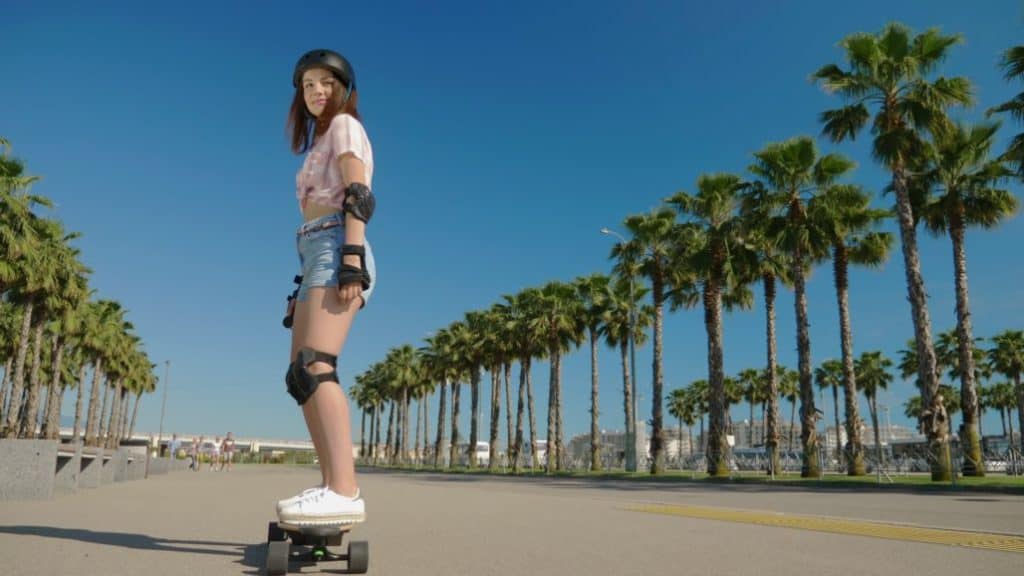
If I’m riding over rough terrain, what foot should I be stepping with?
It’s recommended that you use your left foot if possible because this is the main part of your body that will be making contact with the ground when doing slides, so it makes sense that this should be the first thing to touch down onto the ground; however, if there are a lot of hard bumps on the road then I’d recommend using your right foot instead because it’s softer and will dampen some of the shocks!
What can I do to avoid wheel bite when doing slides?
If you’re afraid of wheel bite when doing slides, then the first thing that I’d recommend is to use a softer bushing since these tend to flex much more than harder ones, and this means that the board will be able to absorb some of the impacts when applied!
Also, keep in mind that over tightening your trucks can also cause wheelbite! When testing out new wheels, it’s important to make sure that they’re correctly tightened, so just check for even tension on all four sides; if you notice any abnormal tension, loosen them off slightly.
What kind of paint should I get for my board?
The main things that you should look out for would be abrasion resistance as well as UV protection; however, bear in mind that this might not be needed for those who are just looking to use their Longboard as a cruiser since the main goal of these is aesthetics rather than durability!
How can I stop my nose and tail from chipping?
The best way to protect your board’s nose and tail from chipping would be by using a decent grip tape, but if you’re missing out on this, then there are always other ways that you can protect it; keep in mind that thick decks don’t chip as easily, but at the same time, they also aren’t as flexible so try not to apply too much pressure onto them when doing slides.

What parts make up a complete longboard?
The main parts that make up a complete longboard are the deck, trucks, wheels and bearings; however, if you want to build your own custom board, then there’s always room for improvement since only these 4 things have to be in place!
What is the difference between slide wheels and freeride wheels?
A: Slide wheels are usually harder (87a-94a) than freeride ones, so they’re mostly used for sliding on the pavement as well as doing tricks such as Ollies. Freeride wheels range from 70b -80 a. The hardness depends on what kind of riding you will be doing with them. If it’s downhill or freeriding, I would recommend going over 80a. But if it’s Park or Street, then I would go under 80a.
If you are looking to do tricks, what wheels should I get?
A: If you are into doing street/park skating, you will need a wheel that is hard and has a high rebound(oabb). But if it’s downhill skateboarding, you might want to get some soft slide wheels. For freeride type of skating, the hardness range is 70b-80a, but for street and park, it can go up to 90b depending on what kind of riding style you will be using them for!
How much weight can my deck handle before breaking?
There isn’t really an answer to this since many factors such as truck setup and board flex come into play; however, the general consensus is that anything within 7lbs-9lbs would be fine.

What are my best options when looking for truck upgrade parts?
You can either get a harder bushing or an even harder wheel since these 2 things will have the biggest impact on your ride! What kind of bushings should I use?
This really depends on which riding style you’re using them for, and just to give you some ideas, super hard ones are ideal if you want to do tricks, while softer ones will help you out with those crazy hills! Also, it’s important to make sure that they’re properly tightened.
What wheels do you recommend for riding on not-so-smooth surfaces?
There are actually quite a few options available for you, but it’s important to note that the ones that work best will heavily depend on which kind of surface you’ll be riding them on; if your main goal is to ride downhill, then you should get some slide wheels since these tend to last longer than their freeride counterparts!
How can I make my Longboard faster?
In order to increase your speed, there are many ways that you can go about doing this, such as changing the bushings (i.e. softer/harder) and even using slightly harder wheels! Just make sure that they’re not too hard since this could cause problems when doing slides! Also, keep in mind that a good stance will also aid
Why does my board stop suddenly when I hit a crack on the pavement?
The reason why your board stops suddenly are due to the fact that there’s not enough grip between it and the pavement. The way around this problem would be by using a solid grip tape or, even better, fatter wheels!

What’s the best kind of board for me?
There really isn’t a one size fits all answer for this since people who are into aggressive skating will need something different from those who like to do more cruising! Also, consider what you’ll be riding on as well since hard and thick boards usually aren’t ideal for doing tricks, while thinner ones can help out with thicker cracks…
What should I look for if I’m trying to replace my current deck?
There are many things that you should take into consideration when looking to replace your longboards, such as the length, flexibility, weight, and truck compatibility. You should also take into account what sort of riding you’ll be doing since certain features will be more useful for one than another; if you want a long deck with high stability, then TKP is your best bet, but if you need a shorter board that can easily turn then RKP would probably work best!
How do I choose between having a top mount or drop through?
These 2 types fall under the same category because they are both considered “drop-through” decks. The difference boils down to preference and what kind of mounting system they’re using; drop-throughs tend to feature ABEC 7 bearings, while some top mounts could have bushings instead.
Should I get slide gloves?
The answer to this question really depends on how comfortable you are with sliding and the kind of experience that you want while doing so! There are people who prefer wearing them while others just learn to do it bare-handed; for example, wearing gloves can help minimize slippage, but by not wearing anything at all, you’ll be able to feel the board better.

How important is a premium deck?
This is actually a pretty tricky question since there’s no definitive way to tell what makes a good longboard or what separates an average from a great one. However, we can still make some generalizations about these decks, such as their “pop”, which refers to just how much energy they store when performing a trick; this factor will heavily depend on the board’s construction, so one with a good pop will feel as if it’s ready to perform another trick right away!
Can I use my longboards for commuting?
This is actually an excellent way to use your Longboard since they’re not only more economical but also much faster compared to using the usual form of transportation. Depending on the size, though, you’ll find that some boards might be too big, which could result in security issues; despite this, you can still look for something smaller or just throw a lock on it!
How do I choose between drop-thru and top mounts?
Top mounts are often cheaper than drop-thrus, but they feature bushings instead of hard and high quality bearings. The choice between these 2 is really up to the type of riding that you’re looking to do since drop-thru decks have a better turning radius but can feel more sluggish, while top mounts could be better for downhill and freeride!
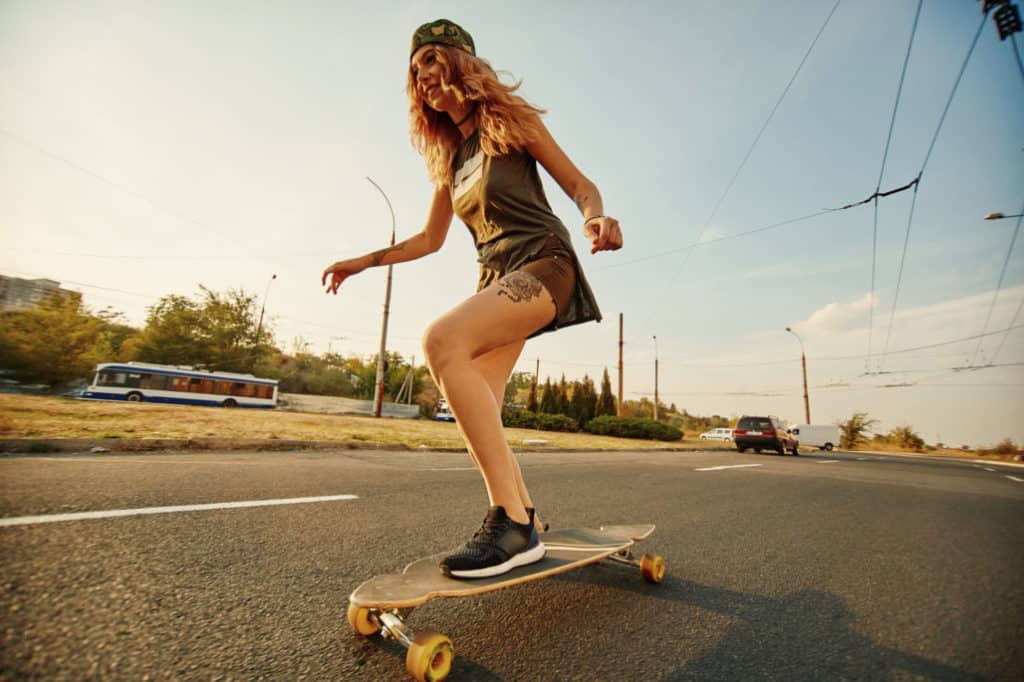
How much should I spend on a good longboard?
This really depends on what kind of money you want to put into your new deck; if it’s a gift or something that only happens once in a while, then there’s no need to overspend on one since they can still perform beautifully; even with mid-range prices! Also, don’t forget about other things such as trucks and wheels when budgeting because those are arguably more important than the deck itself…
Skateboarding pads are expensive! Do I really need them?
Well, this really depends on what you’re looking to do. For newer or recreational users, it’s a good idea to invest in knee pads since they can help prevent injuries and even make learning easier; however, for more serious riders then elbow pads might be something to look into because those are the areas that take the most beating when riding!
Can longboards be made from bamboo?
Yes! It is true that some of these decks use bamboo plywood, and while they’re just as strong if not stronger than other decks out there, there still isn’t an overwhelming amount of them, so finding them might take a bit; of work! Also, you should know that these boards don’t necessarily have better quality compared to cheaper ones…

Do helmets look funny?
This really depends on the type of helmet that you’re using. Some helmets can make your head look like a mushroom, while others are so sleek and clean-looking that you might not even notice when wearing them!
What are leathers, and when do I need them?
Leathers are the skaters’ equivalent of runners’ sneakers; they’re designed to protect their feet from getting hurt due to repeated impacts on the ground. But this doesn’t mean that you should start wearing them always since that could cause other problems such as giving you chafing if there’s too much friction against your skin!
How heavy is a longboard?
Well, it really depends on its size and construction. Some boards might be around 5 pounds while others could hit up to 20 or more; some of this will also depend on what truck or wheel setup you’re using, so in essence, just get something comfortable for long distances; otherwise, it’ll take you forever just walking back home!
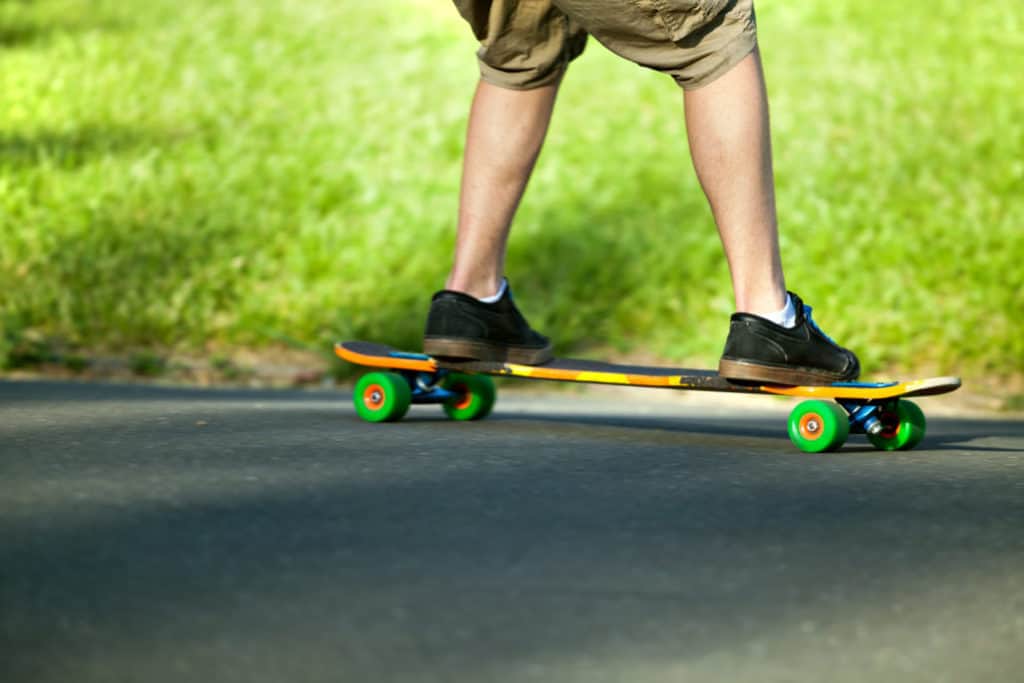
Will my Longboard come ready to ride?
This also depends on the shop you’re buying from, but most of them should have your board ready to ride. You can check this by asking if they’ve already taped it or if they’ll do so after paying for it; as a general rule, though, make sure that everything will be working fine before riding out!
How much does a longboard weigh?
One of the biggest concerns that first-time buyers have is how heavy their boards are, and while I’m not going to tell you exactly how much each weighs, I’ll say that you shouldn’t worry too much about this factor since most of them come with a carrying handle or bag which would make transporting easier!
What Should I wear for riding boards?
This is a question that has become more important nowadays because while there are still some people who go skating in shorts and t-shirts, a lot of skaters today are serious about their appearance, so pants and jackets have started to become extremely popular.
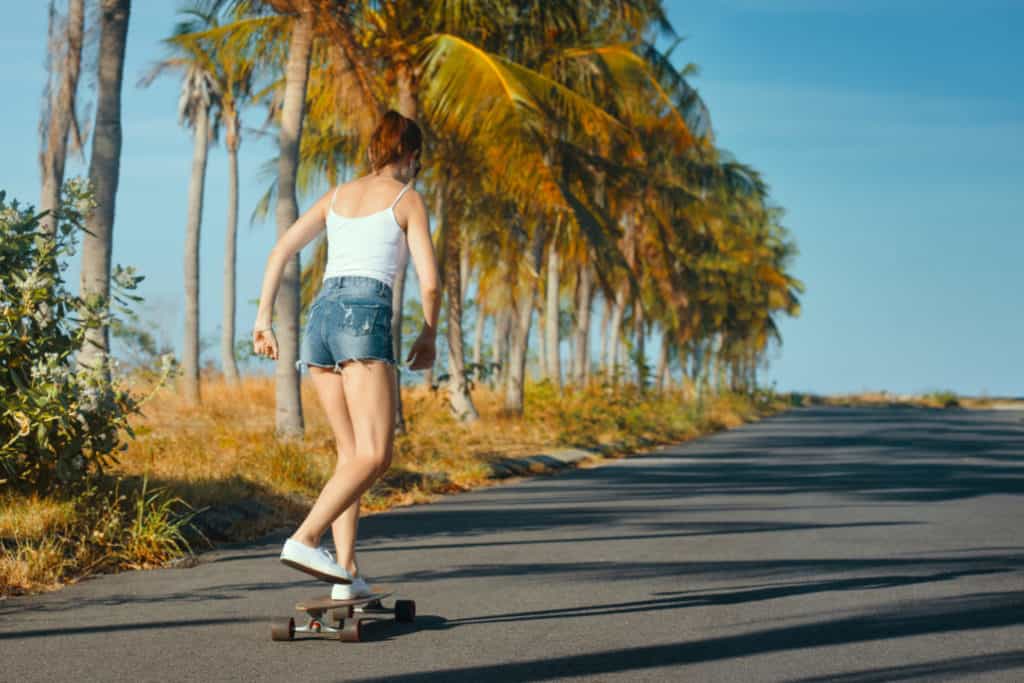
Does wood make a difference when it comes to skateboarding decks?
If you’re looking for something with a great turning radius, then going with a maple deck would be ideal since it’s much easier to do slalom or carve circling around obstacles! However, if it’s the downhill speed that you want, then going with one made from bamboo might be better suited for you since they’re both considerably lighter than other types of woods. Also, keep in mind that different types of wood can differ greatly depending on the manufacturer, which is why it’s important to look into what they’re using!
How do I know if a skateboard is slow or fast?
It looks the same no matter how you turn it. This is because of its construction; longboards are designed with either concave or convex decks, so when you push on one part, then the other part would rise up. This can be seen clearly in boards with rocker style decks since these have a slight bend near their nose and tail ends! But this doesn’t mean that rocker trucks aren’t good for speed skating since there are some setups that can allow such features!
Final Thoughts

Thanks for reading this article on Riding Boards! Hopefully, You should be adept at all the basic lingo and details of longboards in no time after reading it. I’ve also included some more advice and answer to some questions to help you out but, if you need a particular question covered, please drop a note in the comments section below.
Happy Riding!
Sharing is caring!


